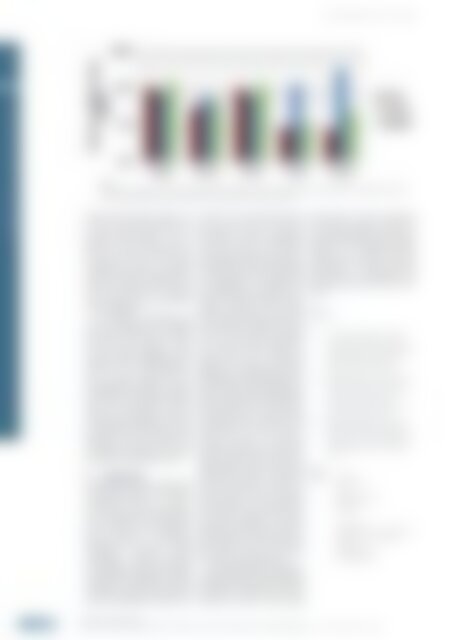Erfolgreiche ePaper selbst erstellen
Machen Sie aus Ihren PDF Publikationen ein blätterbares Flipbook mit unserer einzigartigen Google optimierten e-Paper Software.
<strong>atw</strong> Vol. 63 (<strong>2018</strong>) | Issue 1 ı January<br />
OPERATION AND NEW BUILD 32<br />
| | Fig. 2.<br />
Comparison of the total annual effective dose obtained for several radionuclides with the model in RP101 [2] and with SUDOQU. Values labelled as SUDOQU*<br />
are obtained by applying the same removable fraction and wipe-off efficiency as those used in RP101.<br />
between these opposite effects. For<br />
Co-60 and Na-22, the smaller value<br />
of the external-radiation dose in<br />
SUDOQU (with respect to that in<br />
RP101) is not fully compensated by<br />
the larger values of the other dose<br />
contributions, leading to a slightly<br />
smaller total dose in SUDOQU. For<br />
the other considered nuclides ( Cs-137,<br />
Sr-90 and Pu-241), the opposite<br />
occurs, leading to more conservative<br />
results in SUDOQU.<br />
An additional comparison was<br />
made by implementing in SUDOQU<br />
the same assumptions as in RP101<br />
concerning the removable fraction<br />
and the transfer efficiency. These<br />
results are shown in Figure 2 as well,<br />
indicated by the label SUDOQU*.<br />
Due to these assumptions, the<br />
external-gamma-radiation exposure<br />
in SUDOQU* now increases to values<br />
larger than those in RP101, while the<br />
other dose contributions decrease,<br />
although still being larger than the<br />
values obtained in RP101. As a result,<br />
the annual dose values obtained with<br />
SUDOQU* are more conservative for<br />
all considered nuclides, but in good<br />
agreement with the RP101-results.<br />
4 Conclusions<br />
The SUDOQU model [1] enables dose<br />
evaluations for exposure to a surfacecontaminated<br />
object. It is characterised<br />
by the innovative and distinctive<br />
assumption of time-dependent<br />
surface- and indoor air-contamination<br />
levels governed by mass-balance<br />
equations based on the following<br />
mechanisms: radioactive decay,<br />
resuspension, wipe-off, deposition<br />
and ventilation. These features make<br />
the SUDOQU methodology a suitable<br />
candidate for performing clearance<br />
calculations based on reuse scenarios,<br />
where the individual is likely to be<br />
exposed to the same object throughout<br />
the year, and for which the<br />
assumption of constant contamination<br />
levels would be unrealistically<br />
conservative. In this work, a surfacecontaminated<br />
bookcase released from<br />
the controlled area of a nuclear facility<br />
is studied, with the aim of assessing<br />
the applicability of SUDOQU for<br />
the development of surface-clearance<br />
criteria for nuclear facilities. Deterministic<br />
calculations of the annual<br />
effective dose were thus conducted for<br />
several nuclides in different scenarios<br />
of use. First, the results in this paper<br />
reveal a strong nuclide dependency:<br />
even within the same category of<br />
emitters there can be pronounced<br />
differences in absolute dose values,<br />
depending on the radiological characteristics<br />
of the nuclides and their metabolic<br />
behaviour and radiobiological<br />
impact on the human body. Moreover,<br />
the consideration of a mass balance<br />
describing the time evolution of the<br />
contamination levels causes the total<br />
annual dose to be the result of<br />
a delicate interplay of the involved<br />
elements. In this way, a variation of a<br />
certain input parameter may lead to<br />
opposite effects on the various dose<br />
contributions, and thus to a total dose<br />
that either decreases, increases or<br />
remains constant. The net outcome<br />
again depends on the characteristics<br />
of the nuclide and on the specifics of<br />
the exposure scenario. The results<br />
obtained with SUDOQU were benchmarked<br />
against the results reported in<br />
RP101 [2] for the reuse scenario of a<br />
tool cabinet, and the two models<br />
proved to be in good agreement.<br />
The results presented in this paper<br />
not only demonstrate the suitability of<br />
SUDOQU for dose assessments related<br />
to clearance of objects from nuclear<br />
facilities, but they are also a good<br />
starting point to better understand<br />
the intricate interplay among the<br />
involved mechanisms. Their interaction<br />
also disclosed the importance and<br />
difficulty of a detailed sensitivity<br />
analysis. Future work will focus on the<br />
development of surface clearance<br />
levels based on probabilistic and<br />
realistically conservative dose assessments.<br />
References<br />
[1] T. van Dillen, SUDOQU: a new dose<br />
model to derive criteria for surface<br />
contamination of non-food (consumer)<br />
goods, containers and conveyances,<br />
Radiation Protection Dosimetry,<br />
164(1-2) (2015), pp. 160-164.<br />
[2] Radiation Protection 101: Basis for the<br />
definition of surface contamination<br />
clearance levels for the recycling or<br />
reuse of metals arising from<br />
dismantling of nuclear installations,<br />
European Commission, 1998.<br />
[3] ICRP, Age-dependent Doses to the<br />
Members of the Public from Intake of<br />
Radionuclides - Part 5 Compilation of<br />
Ingestion and Inhalation Coefficients,<br />
ICRP Publication 72. Ann. ICRP 26 (1),<br />
1995.<br />
Authors<br />
F. Russo<br />
C. Mommaert<br />
Bel V<br />
Rue Walcourt, 148<br />
1070 Brussels,<br />
Belgium<br />
T. van Dillen<br />
National Institute for Public Health<br />
and the Environment (RIVM)<br />
P.O. Box 1<br />
3720 BA Bilthoven,<br />
The Netherlands<br />
Operation and New Build<br />
Clearance of Surface-contaminated Objects from the Controlled Area of a Nuclear Facility: Application of the SUDOQU Methodology ı F. Russo, C. Mommaert and T. van Dillen

















